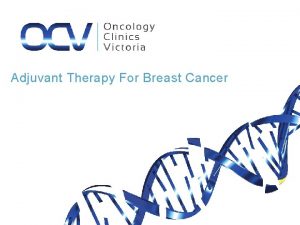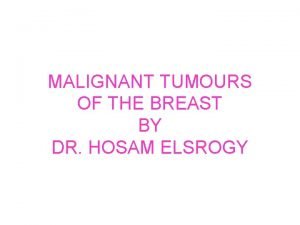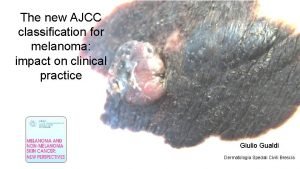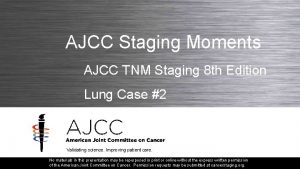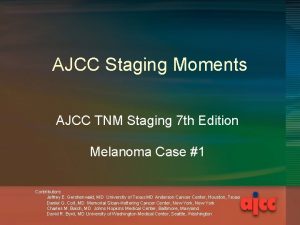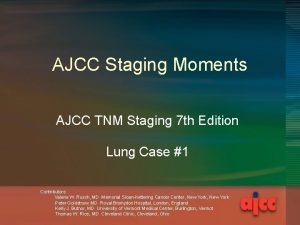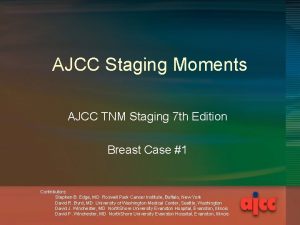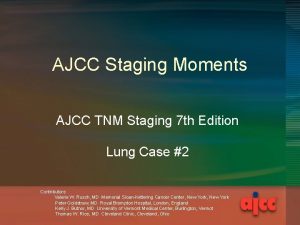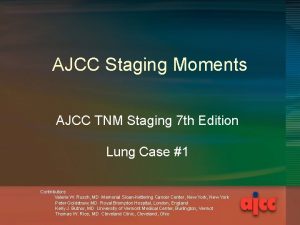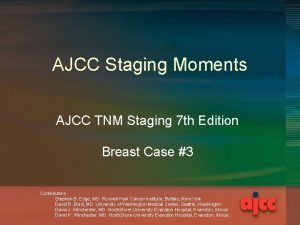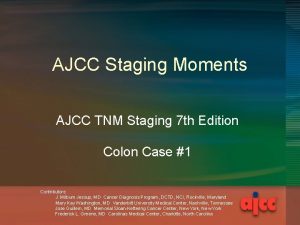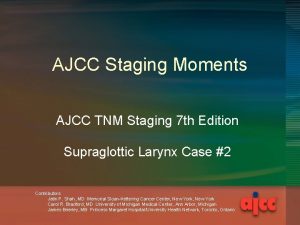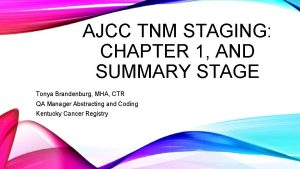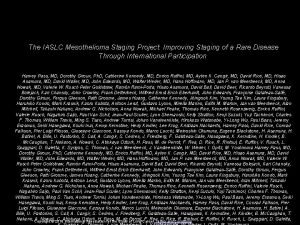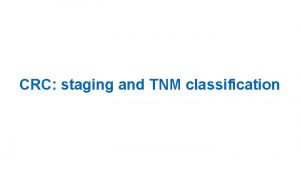HOW TO USE THE AJCC CANCER STAGING MANUAL












































- Slides: 44

HOW TO USE THE AJCC CANCER STAGING MANUAL, 8 TH EDITION FCRA Annual Educational Conference Orlando, Florida July 25, 2017 Steven Peace, CTR 1

Outline • History, Purpose and Background • Purchase and Ordering Information & Errata • Introduction to AJCC Cancer Staging Manual, 8 th ed. • AJCC Cancer Staging Manual Organization • General Chapter Outline and Contents • Specific Neoplasms Included by Chapter • Neoplasms Not Included in the AJCC Manual • Locating the Correct Chapter for a Case • AJCC 8 th Edition Staging Rules • Other Helpful Information • Questions 2

History, Purpose and Background • The AJCC Cancer Staging Manual is used by physicians, cancer registries, and other allied health care professionals throughout the world to provide consistent nomenclature to describe cancer stage and to facilitate the uniform description and reporting of cancer staging for most adult neoplastic diseases. • Staging provides patients with cancer and their physicians the critical benchmark and standards for defining prognosis, the likelihood of overcoming the cancer once diagnosed, and for determining the best treatment approach for the disease. • Staging also forms the basis for understanding the changes in population cancer incidence, the extent of disease at initial presentation, and the overall impact of improvements in cancer treatment. • A major challenge to TNM Staging is the rapid evolution of knowledge in cancer biology and the discovery and development of biologic factors that predict cancer outcome and response to treatment with better accuracy than purely anatomically based staging. • However, anatomic extent of disease remains the key prognostic factor, the strongest predictor of outcome, in most diseases. Therefore, the T, N, and M components remain purely anatomic. • The Eighth Edition of the AJCC Cancer Staging Manual brings together all the currently available information on staging of cancer at various anatomic sites and incorporates new knowledge on the etiology and pathology of cancer…supplemented by selected genetic and biomolecular tumor markers. 3

Purchase and Ordering Information • AJCC Cancer Staging Manual – 8 th edition, 2017 • COST: $119. 99 • ISBN: 978 -3 -319 -40617 -6 • 1429 pages • 512 illustrations • 187 color illustrations • Required - Florida Mandate • FCDS will not purchase • Facility may purchase • Individual may purchase ON s O S ion G IN Vers M CO ook or ndle f Ki E-b on Book z a ei m A ppl A • https: //cancerstaging. org • http: //springer. com • 1 -800 -SPRINGER 4

AJCC Cancer Staging Manual, 8 th ed - Errata 5

Intro to AJCC Staging Manual, 8 th ed. • Enhanced Chapter 1 – Principles of Cancer Staging • Enhanced Descriptions of Staging Rules – Chapter 1 • • • Timing for Staging Clinical Staging Criteria and General Rules Pathologic Staging Criteria and General Rules for Assigning T, N, and M Category Codes Rules for Determining Prognostic Stage Group Timing and Criteria for Post-Therapy Staging (yc/yp) • 12 new staging systems • 83 total chapters defined by site/subsite and specific histologies • New Site-Specific Fields – no more “factors” – but similar instructions and codes 6

Intro to AJCC Staging Manual, 8 th ed. • New Sections or Features within Chapters • • • AJCC Levels of Evidence for Changes to Staging Criteria Guidance on the Use of Imaging to Evaluate Stage for Each Chapter Prognostic Factors • • • Factors Required to Assign Prognostic Stage Group Factors Recommended for Managing Patient Care Emerging Factors Risk Assessment Models Clinical Stratification Recommendations • Chapter-Specific Histology Codes – No longer uses range of acceptable codes – • Histology Code List updated with 2018 MPH Rules to ensure all new for 2018 histology codes are included in appropriate chapter(s) – and to keep up with WHO Classifications 7

Intro to AJCC Staging Manual, 8 th ed. • New Chapters for 8 th edition • Head and Neck Cervical Lymph Nodes with Unknown Primary – check for EBV or HPV Status • HPV-Mediated (p 16+) Oropharynx Cancer – When p 16 - Use Oropharynx (p 16 -) or Hypopharynx • Cutaneous Squamous Cell Carcinoma of Head and Neck • • Thorax • • Thymus Endocrine System Parathyroid • Adrenal Neuroendocrine Tumors • • Hematologic Malignancies • Leukemia 8

Intro to AJCC Staging Manual, 8 th ed. • Split Chapters for 8 th edition • Pancreas Exocrine Pancreas – Hepatobiliary System • Neuroendocrine Tumor of Pancreas – see Neuroendocrine Tumors (NET) • • NET of Stomach NET of Duodenum and Ampulla of Vater NET of Jejunum and Ileum NET of Appendix NET of Colon and Rectum NET of Pancreas 9

Intro to AJCC Staging Manual, 8 th ed. • Split Chapters for 8 th edition • Bone – multiple staging tables with T Category Code based on type/location of primary Appendicular Skeleton • Pelvis • Spine • • Soft Tissue Sarcoma • • Introduction to Soft Tissue Sarcoma of Head and Neck Soft Tissue Sarcoma of Trunk and Extremities Soft Tissue Sarcoma of Abdomen and Thoracic Visceral Organs Soft Tissue Sarcoma of Retroperitoneum Soft Tissue Sarcoma – Unusual Histologies and Sites GIST is now in Soft Tissue Sarcoma Section 10

Intro to AJCC Staging Manual, 8 th ed. • Merged Chapters for 8 th edition Ovary, Fallopian Tube, Primary Peritoneal Carcinoma • Consistent with WHO Classification, 4 th edition • Allows GYN Staging of C 48. 2 Cases • Surface Epithelial – Epithelial Stromal Tumors Serous tumors: • Benign (cystadenoma) • Borderline tumors (serous borderline tumor) • Malignant (serous adenocarcinoma) Mucinous tumors, endocervical-like and intestinal type: • Benign (cystadenoma) • Borderline tumors (mucinous borderline tumor) • Malignant (mucinous adenocarcinoma) Endometrioid tumors: • Benign (cystadenoma) • Borderline tumors (endometrioid borderline tumor) • Malignant (endometrioid adenocarcinoma) Clear cell tumors: • Benign • Borderline tumors • Malignant (clear cell adenocarcinoma) Transitional cell tumors: • Brenner tumor of borderline malignancy • Malignant Brenner tumor • Transitional cell carcinoma (non-Brenner type) Epithelial-stromal: • Adenosarcoma • Carcinosarcoma (formerly mixed Mullerian tumors) 11

Changes from AJCC Staging Manual, 7 th ed. 12

AJCC 8 th Edition Staging Rules – Chapter 1 • Entire 30 pages devoted to Staging Rules and is Table-Driven with User Notes • Definitions are included for vocabulary related to cancer staging • Clarification on Use of “X”, <blank> and Zero (0) • Clarification on Use of Clinical & Pathological Stage Descriptors • Clarification on “Response to Neoadjuvant Therapy” • Explanation for How to Apply Tables to Assign New Prognostic Stage Groups • AJCC will be hosting webinar(s) on Key Elements of Chapter 1 – General Rules • 2018 FCDS Abstractor Code Test Absolutely WILL Have Questions from Chapter 1 13

AJCC 8 th Edition Staging Rules - PDF 14

AJCC 8 th Edition – Staging Clarifications 15

Reinforced Concepts – “X” versus <Blank> • Explaining Blanks and X, Ambiguous Terminology and Support for AJCC Staging • Does patient meet criteria for clinical and/or pathological staging? • EDITSv 18 will reinforce training – EDITSv 17 was used to test • “X” indicates something was done for T or N Category Code but result was not clear in the test report to assess the primary tumor size/extent or nodal status. “X” does not equal “Unknown” • <blank> indicates no test was performed, patient not eligible to stage, no info available in medical record on staging to determine T or N Category Code • M Category always be coded when the patient meets eligibility criteria for staging https: //cancerstaging. org/CSE/Registrar/Documents/Explaining%20 Blanks%20 and%20 X, %20 Ambiguous%20 Terminolo gy%20 and%20 Support%20 for%20 AJCC%20 Staging_updated%20 Dec%202015. pdf – this presentation was updated December 2015 and is still valid. • • c. M 0 can be used for clinical no evidence of mets AND for pathological when mets not proven histologically p. M 1 is histologically proven mets (bx or resection) and can be used for clinical and pathological 16

Using the AJCC 8 th edition API (AJCC API) • The American Joint Committee on Cancer (AJCC) has developed an Application Programming Interface to deliver the 8 th Edition Cancer Staging System in XML format. For the first time, the AJCC will be making the Cancer Staging System available in an XML format to directly integrate into software and applications. • This will allow software developers to: Focus on usability of software rather than accuracy of the AJCC content • Integrate once and maintain connection for all future versions of AJCC Staging System • Take advantage of upcoming enhancements to API content in real-time • Benefit from the most accurate and up-to-date AJCC Staging System in your software • 17

AJCC Staging Manual Organization – Chapter 2 • Table of Contents • Part I – General Information on Cancer Staging and End-Results Reporting • Part II – Head and Neck ( Chapters 5 -15) • Part III – Upper GI Tract (Chapters 16 -18) • Part IV – Lower GI Tract (Chapters 19 -21) • Part V – Hepatobiliary System (Chapters 22 -28) • Part VI – Neuroendocrine Tumors (Chapters 29 -34) • Part VII – Thorax (Chapters 35 -37) • • Chapter 1 – Principles of Cancer Staging Chapter 2 – Organization of the AJCC Cancer Staging Manual Chapter 3 – Cancer Survival Analysis Chapter 4 – Risk Models for Prognosis in Practice of Precision Oncology 18

AJCC Staging Manual Organization – Chapter 2 • Part VIII – Bone (Chapter 38) • Part IX – Soft Tissue Sarcoma (Chapters 39 -45) • Part X – Skin (Chapters 46 -47) • Part XI – Breast (Chapter 48) • Part XII – Female Reproductive System (Chapters 49 -56) • Part XIII – Male Genital Organs (Chapter 37 -59) • Part XIV – Urinary Tract (Chapters 60 -63) • Part XV – Opthalmic Sites (Chapters 64 -71) • Part XVI – Central Nervous System (Chapter 72) • Part XVII – Endocrine System (Chapters 73 -77) • Part XVIII – Hematologic Malignancies (Chapters 78 -83) 19

What Happened to the Staging Forms? • Staging Forms for recording cancer staging data will be available on ww. cancerstaging. org. • These printable forms may be used by physicians to record data on T, N, and M categories; prognostic stage groups; additional prognostic factors; cancer grade; and other important information. • This form may be useful for recording information in the medical record and for communicating information from physicians to the cancer registrar. • The cancer staging form is a document for the patient record; it is not a substitute for documentation of history, physical examination, and staging evaluation, or for documenting treatment plans for follow-up. • Staging Forms may be used by individuals without permission from the AJCC or the publisher. 20

General Chapter Outline and Contents 21

Specific Neoplasms Included by Chapter 22

Neoplasms Not Included in Manual/Chapter 23

Locate the Correct Chapter/Section for this Case OR 24

Review Clinical & Pathological Criteria for this Chapter – Does Case Meet Criteria? • Rules for Classification - Urinary Bladder • Clinical Classification – “Primary tumor assessment includes cytoscopic assessment, bimanual examination before and after endoscopic surgery (biopsy o transurethral resection), radiographic evaluation, and histologic verification of the presence or absence of tumor when indicated. All factors are important in determining a clinical stage of disease. Despite optimal evaluation, clinical understaging and over-staging remains a concern…(continued)…” • Imaging – “Imaging is recommended to stage and characterize most newly diagnosed bladder cancer. Published guidelines recommend pelvic and upper-tract evaluations for all patients with higher risk bladder tumors. As most patients with bladder cancer present with hematuria, imaging evaluation of the upper urinary tract using CT or MRI urography is recommended…. Imaging plays a complementary role to deep biopsy in local staging of bladder cancer…(continued)…” • Pathological Classification – “Pathological staging is performed on partial cystectomy and radical cystectomy specimens and is based on both gross and microscopic assessment…. A p. N status should be assessed regardless of the number of lymph nodes examined and irrespective of the laterality of the lymph nodes extracted. If no lymph nodes are evaluated, p. NX status should be assigned…(continued)…” 25

Apply General plus Chapter-Specific Rules • Chapter 1 – General Staging Rules – READ THOROUGHLY and USE ALWAYS • General Staging Rules PDF – READ THOROUGHLY and USE ALWAYS • Chapter-Specific Rules – Priority Over General Rules – READ THOROUGHLY and APPLY CAREFULLY • Many New Anatomic Drawings Added to AJCC 8 th edition – Use them • WARNING: Software Drop Down Select Menus do not include Rules • WARNING: EDITS cannot identify all circumstances when rules apply 26

Determine the Best T, N, and M Category Code for Clinical and Pathological Stage 27

Did the Patient Receive Neo. Adjuvant Tx? • Isn’t ‘yp’ stage the same as pathological staging? NO – measures response to TX • What is Neoadjuvant Treatment? What is Intent of this Treatment? • Does any treatment given before surgery qualify as neoadjuvant? • What are exceptions to treatment given before surgery that is not neoadjuvant? • What about treatment given for late stage cancer – can this be neoadjuvant? • What about hormone therapy given before prostate or breast surgery? • What are common cancer conditions that qualify to receive neoadjuvant therapy? Breast – large tumor, clinically positive nodes • Rectal – any tumor, any nodal status • Lung – early stage, tumor location and size, resectable or not, histology • • DON’T FORGET TO CODE THE DESCRIPTOR FOR THESE CASES – very important!!! 28

Importance of Cancer Genomics - NCI • Cancer is a genetic disease. • Cancer genomics research contributes to precision medicine by defining cancer types and subtypes based on their genetics and identify targets for new medicines • “targeted therapies” specifically combat characteristics of cancer cells that are different from normal cells of the body. This makes them less likely to be toxic for patients compared to other treatments such as chemotherapy and radiation that can kill normal cells. • How do “targeted therapies” work? • Inhibit enzymes that trigger the abnormal growth and survival of cancer cells • • Block aberrant gene expression characteristic of cancer cells • • Imatinib (Gleevec) inhibits overactivity of protein Bcr-ABL tyrosine kinease in leukemia patients Trastuzumab (Herceptin) controls hyperactive signaling pathway (HER 2 tyrosine kinase) - breast Halt molecular signaling pathways that are in overdrive in cancer cells • Erlotinib (Tarceva) and gefitinib (Iressa) both restrict activation opf a protein (EGFR) in lung cancers 29

Tumor Marker or Genetic Alteration Tumor Marker • Tumor Markers are indicators of cellular, biochemical, molecular or genetic alterations by which neoplasia can be recognized. • Tumor markers detect the presence of tumor based on quantitative and/or qualitative measurements in blood or secretions found in cells, tissues or body fluids. • • These surrogate measures of the biology of the cancer provide insight in the clinical behavior of the tumor. Biochemical or immunologic counterparts of differentiation states of tumor. Genetic Alteration • Cancer is a multigene disease that arises as a result of mutational and epigenetic changes coupled with activation of complex signaling intra and extra cellular networks. • Alterations in 3 Classes of Genes • Proto. Oncogenes • Tumor Suppressor Genes • DNA Repair Genes • Resultant effects on death mechanisms embedded within cells coupled with dysregulation of cell proliferation events. • Types of Mutations • Gene Rearrangement • Point Mutations • Gene Amplification 30

Comparison of the histopathology, molecular pathology, genetic, and gene-expression analysis methods used to delineate breast cancer tumor subtypes and suggested current and future therapies in a historical context http: //www. nature. com/article-assets/npg/nrclinonc/journal/v 4/n 9/images/ncponc 0908 -f 1. jpg 31

Today – Precision Cancer Medicine Workup 32

Site-Specific Fields Required for Staging HER 2 • Each Chapter includes the Site-Specific Fields Required for Staging (if any) • You MUST also document ALL Site-Specific Field Values/Results in TEXT s B Symptom I CEA MS • You MUST look for these tests and results – they are really important! ER/PR • Analytic Cases MUST include valid entries in these critical fields Immuno. Pheno type • Non-Analytic Cases SHOULD include valid entries as available Ki-67 Index CA 125 • FCDS will monitor overuse of 999 default values CA 199 • Include same tests as CS SSFs for some cancers • Instructions and Codes may differ from CS PSA • Field Length and Location of Decimal • Site-Specific Fields Manual Pending Gle aso • Other – age, LVI, LN +/exam, T Size n tic o t i M nt Cou Sp eci Gra fied de s Cyto. Genetic 33

Sample New SSFs - Required for Staging

Site-Specific Fields – Clinically Relevant Lifestyle Factors o Tobacco Use o Depression o Alcohol Virus Exposures o P 16/HPV o HIV o Hep B or Hep C Overall Health Status o Comorbidity(s) o Overall Health o Performance Status o Zubrod/ECOG o Karnofsky Other Anatomic Info o Location of Positive Lymph Node(s) o Size of Positive Node o Extranodal Extension o Perineural Invasion o Tumor Thickness o Depth of Invasion o Surgical Margins • Clinically Relevant Site Specific Prognostic Variables are in the AJCC Staging Manual • New Site Specific Fields not yet created to store these variables • ALL are Pending Review • None are Required in 2018 • None are Optional in 2018 • No Instructions or Codes – Yet. 35

Site-Specific Fields – Emerging Factors Identification of and Testing for Next Generation Biomarkers, Genetic Tests and Multi-Gene Profiles and Establishing Data Collection Standards for Emerging SSFs 36

Determining Prognostic Stage Groups • MUST MEET THE CRITERIA FOR STAGING TO BE STAGED • Verify ALL Required Variables Have Been Coded • Clinical Prognostic Stage Group • Pathological Prognostic Stage Group • Response to Neoadjuvant Therapy (yp/yc) • Proper Use of Clinical and Pathological Descriptor Fields 37

TNM and Site-Specific Field EDITS Nemesis: the goddess of revenge In the ancient Greek religion, Nemesis was the goddess who enacted retribution against those who succumb to hubris (arrogance before the gods). Another name was Adrastela, meaning “the inescapable” 38

Tips and Pointers • Read Chapter 1 – this is where the General Rules are documented • Specific Chapters may include exceptions to General Rules • Read the Entire Chapter at least once – there are lots of details often overlooked • Read the Entire Chapter at least once – drop down menus do not include specifics for inclusion in staging, staging exclusions, or exceptions or special caveats for specific criteria or staging guidelines within each specific cancer site chapter • Use EDITS to learn staging rules – DO NOT USE to change data just to “pass” edits • Practice - Use Reliable Resource for Answers & Rationale • Ask for Assistance as Needed 39

AJCC Staging Manual Site-Specific Training 40

Helpful Information https: //cancerstaging. org 41

Helpful Information http: //onlinelibrary. wiley. com for copies of articles • CA Cancer J Clin. 2017 Mar 14. doi: 10. 3322/caac. 21393. • Breast Cancer—Major Changes in the American Joint Committee on Cancer 8 th Edition Cancer Staging Manual • March/April 2017 - Volume 67, Issue 2 • The 8 th Edition AJCC Cancer Staging Manual: Continuing to build a bridge from a population-based to a more “personalized” approach to cancer staging • Head and Neck cancers—major changes in the American Joint Committee on Cancer 8 th edition Cancer Staging Manual • Lung cancer — major changes in the American Joint Committee on Cancer 8 th edition Cancer Staging Manual • May/June 2017 - Volume 67, Issue 3 • Prostate cancer – major changes in the American Joint Committee on Cancer 8 th edition Cancer Staging Manual • July/August 2017 – Volume 67, Issue 4 • AJCC Staging Topic(s) TBA 42

Helpful Information http: //ascopubs. org/journal/jco • J Clin Oncol 35: 274 -280. © 2016 by American Society of Clinical Oncology • Modified Staging Classification for Pancreatic Neuroendocrine Tumors on the Basis of the American Joint Committee on Cancer and European Neuroendocrine Tumor Society Systems • Journal of Thoracic Oncology Vol. 12 No. 1: 36 -42 • Cancer of the Esophagus and Esophagogastric Junction: An 8 th Edition Staging Primer 43

Questions 44
 Staging of breast cancer
Staging of breast cancer Breast tnm staging
Breast tnm staging Tnm stage lung cancer
Tnm stage lung cancer Ca mammae staging
Ca mammae staging Glottic cancer staging
Glottic cancer staging Breast cancer tnm staging
Breast cancer tnm staging Prostate cancer staging
Prostate cancer staging Breast cancer staging
Breast cancer staging Microsatellitosi
Microsatellitosi Hát kết hợp bộ gõ cơ thể
Hát kết hợp bộ gõ cơ thể Lp html
Lp html Bổ thể
Bổ thể Tỉ lệ cơ thể trẻ em
Tỉ lệ cơ thể trẻ em Voi kéo gỗ như thế nào
Voi kéo gỗ như thế nào Tư thế worms-breton
Tư thế worms-breton Hát lên người ơi
Hát lên người ơi Các môn thể thao bắt đầu bằng tiếng đua
Các môn thể thao bắt đầu bằng tiếng đua Thế nào là hệ số cao nhất
Thế nào là hệ số cao nhất Các châu lục và đại dương trên thế giới
Các châu lục và đại dương trên thế giới Cong thức tính động năng
Cong thức tính động năng Trời xanh đây là của chúng ta thể thơ
Trời xanh đây là của chúng ta thể thơ Mật thư tọa độ 5x5
Mật thư tọa độ 5x5 Phép trừ bù
Phép trừ bù Phản ứng thế ankan
Phản ứng thế ankan Các châu lục và đại dương trên thế giới
Các châu lục và đại dương trên thế giới Thể thơ truyền thống
Thể thơ truyền thống Quá trình desamine hóa có thể tạo ra
Quá trình desamine hóa có thể tạo ra Một số thể thơ truyền thống
Một số thể thơ truyền thống Bàn tay mà dây bẩn
Bàn tay mà dây bẩn Vẽ hình chiếu vuông góc của vật thể sau
Vẽ hình chiếu vuông góc của vật thể sau Biện pháp chống mỏi cơ
Biện pháp chống mỏi cơ đặc điểm cơ thể của người tối cổ
đặc điểm cơ thể của người tối cổ Thế nào là giọng cùng tên
Thế nào là giọng cùng tên Vẽ hình chiếu đứng bằng cạnh của vật thể
Vẽ hình chiếu đứng bằng cạnh của vật thể Tia chieu sa te
Tia chieu sa te Thẻ vin
Thẻ vin đại từ thay thế
đại từ thay thế điện thế nghỉ
điện thế nghỉ Tư thế ngồi viết
Tư thế ngồi viết Diễn thế sinh thái là
Diễn thế sinh thái là Dot
Dot Bảng số nguyên tố lớn hơn 1000
Bảng số nguyên tố lớn hơn 1000 Tư thế ngồi viết
Tư thế ngồi viết Lời thề hippocrates
Lời thề hippocrates Thiếu nhi thế giới liên hoan
Thiếu nhi thế giới liên hoan

